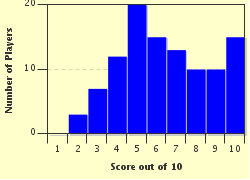Quiz Answer Key and Fun Facts
1. From 900 to 1150 AD, Chaco Canyon was one of the biggest settlements in North America until famine brought on by severe drought most likely forced the abandonment of the site. In which US state can these Anasazi ruins be found?
2. The Skull Famine occurred around the year 1790 on the Indian subcontinent. Which of the following was a cause of the famine?
3. The Band-Aid project established by (Sir) Bob Geldoff and Midge Ure helped to focus attention on the plight of which famine ravaged country during the 1980s?
4. The Great Chinese Famine of 1958 to 1961 followed which economic and social campaign of Mao?
5. In which part of the Soviet Union did Joseph Stalin create an environment that led to an enforced famine and the death of millions of people?
6. In World War II during the Siege of Leningrad, amongst the many victims during this siege were a small group of botanists. They died of starvation protecting what type of bank?
7. The Warsaw Ghetto was established during which major conflict and led to a man-made famine?
8. The Great Famine or Irish Potato Famine from 1845 to 1852 was mainly the result of a natural disaster, namely potato blight.
9. What is the name of the Irish Republican Army member who led, and eventually perished from, a hunger strike in 1981 as a protest against the prisoner's loss of Special Category status?
10. Adam Smith in his book "The Wealth of Nations" (1776), uses which contemporaneous famine as an example of why monopolies fail to meet the needs of the people?
Source: Author
tazman6619
This quiz was reviewed by FunTrivia editor
bloomsby before going online.
Any errors found in FunTrivia content are routinely corrected through our feedback system.

